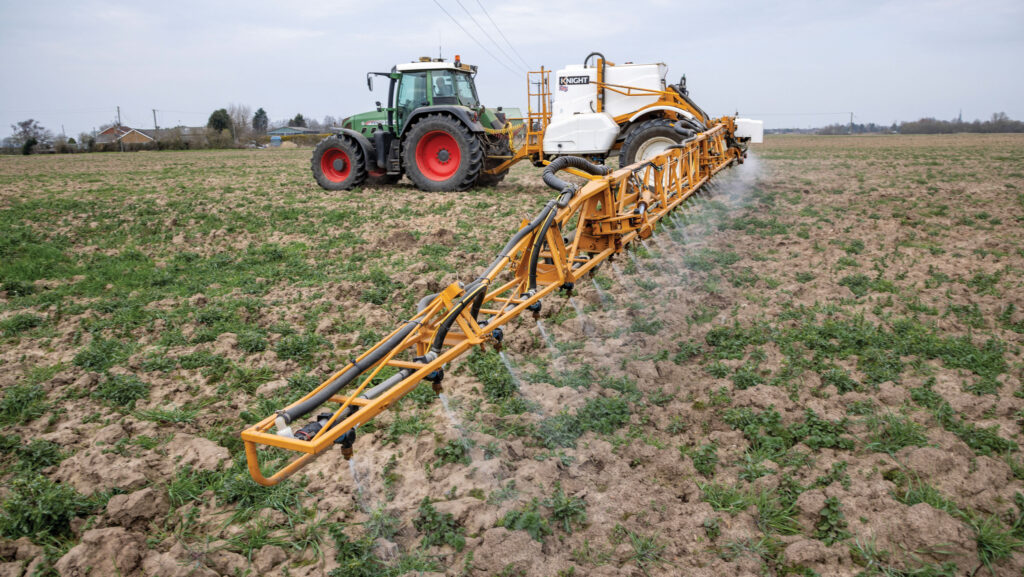How fulvic acid can cut glyphosate rates and improve foliar N
 © Gary Naylor Photography
© Gary Naylor Photography Fulvic and humic acid could be beneficial additions to spray tank mixes, enabling growers to increase efficacy and successfully cut back glyphosate and fertiliser rates by one-third.
Both fulvic and humic acids are natural organic polymers found in soil humus formed as a result of bacterial decomposition of plant and animal matter.
Samuel Deane, an agronomist with New Gen Agri and arable farmer from County Cork, Ireland, explains how the acids bind with nutrients and actives to enhance uptake in a process known as chelation.
See also: Crop nutrition focus saves farmer over £43,000 on costs
“Fulvic acid is a carbon source and chelating agent, with many connection points which enables it to bind to substances and help carry it into the plant,” he says.
It can also neutralise toxic residues of chemical actives in soil, reducing negative effects on beneficial soil microbiology and promoting soil structure.
“Fulvic acid has a greater cation exchange capacity than humic acid which makes it a more powerful chelating agent. It has greater binding potential which provides fast and effective entry of nutrients and chemicals into plants,” Samuel says.
“Humic acid is similar, but with slower chelation power and provides an effective way to kick-start soil biology.”
He explains that as a general rule, fulvic acid helps promote uptake in foliar sprays and humic acid helps promote soil biology and efficacy of soil-applied fertilisers.
Foliar urea
For growers looking to cut back on artificial inputs, he firstly recommends reducing nitrogen rates by 10% each year for three to four years, while introducing foliar urea and fulvic acid.
“Foliar urea with fulvic acid is three times more effective than granular fertiliser – 10kg N/ha of urea and fulvic acid is the equivalent of 30kg granular N/ha,” he says.
Another benefit of adding fulvic acid to urea is reduced scorch damage.
“The differences are very visible. Unchelated N will hit the leaf and enter the plant slower, increasing scorch risk, while fulvic acid’s ability to bind to molecules carries it effectively into plants,” he says.
Glyphosate
Samuel also runs a 40ha arable farm, where fulvic and humic acid play an important role in developing a reduced input system with improved soil health.
When spraying cover crops with glyphosate, fulvic acid has created a faster, more responsive kill from 2.5 litres/ha of glyphosate.
Fields first treated with fulvic acid have improved soil structure with greater soil biology levels which are now entering their fourth year growing fungicide free crops.
Samuel says a humic acid and microbial brew spray helped overcome soil compaction in the top inch of soil, as a result of intense summer rainfall.
“Two weeks after the spray was applied, we were drilling crops and the soil smelt sweet. There were so many earthworms travelling through the tight layer which was not previously the case – a good indicator of healthy soils.”
Grower successfully cuts glyphosate use by one-third

© GNP
Glyphosate rates have been successfully cut by one-third at Anthony Becvar’s arable farm in East Sussex, through the addition of fulvic and humic acid to tank mixes.
Anthony began using the acids as a soil and plant rejuvenator when compost-making, but wanted to take this a step further and incorporate with glyphosate sprays.
“Given the cost of glyphosate and its unknown future, I thought it would be a good opportunity to trial if we could cut rates or improve uptake. I was a bit hesitant, but decided to give it a go and was pleasantly surprised,” he says.
In February 2022, a trial testing a full rate of 3.5 litres/ha of glyphosate alongside 2 litres/ha of glyphosate with fulvic and humic acid revealed no difference in the speed and efficacy of kill.
Anthony now consistently applies humic and fulvic acid with a 2 litre/ha glyphosate rate and rolled out use of the acids in all pesticide and fungicide tank mixes to enhance efficacy and promote soil health across the 80ha farm.
“Fulvic acid helps stimulate the plant and increase the rate of photosynthesis. It improves uptake of substances from the roots and leaves by promoting stomata to open,” he says.
This spring, he cut glyphosate rates as low as 1.7-1.8 litres/ha on his overwintered stubble.
“It worked really well but I am cultivating afterwards to finalise the kill. If direct drilling maybe I wouldn’t have quite as much confidence to go as low as I did,” he says.
“Farmers are looking at how efficient their crop inputs are and what we can do to improve. I believe there is scope to reduce chemical inputs.
“By looking at additives and getting water quality tested, you can make tank mixes more effective.
“Do a trial and give it a go or talk to farmers that have,” he advises.
Anthony uses the product Vitaplex V8 from Soil Fertility Services at 10 litres/ha which contains fulvic acid and humic acid alongside fish hydrolysate from Sea To Soil and a carbon source called Terra Fed from Quality Liquid Feeds.
Rate recommendations for fulvic and humic acid
Fulvic acid comes in a liquid or soluble powder form, to which New Gen Agri agronomist Samuel Deane recommends a rate of 1-2 litres/ha or 100-150g/ha, respectively.
For humic acid applied with both liquid or granular fertiliser he suggests 5% soluble humates for every kg of N applied. So, for 100kg N/ha, apply 5kg of humates.
“A total of 1kg of soluble humates can be used to make 10 litres of liquid humates on farm. When added to animal slurry – dairy or pig – use 5kg of soluble humates/ha,” he says.
Fulvic and humic acid improves N uptake for Lincs grower
Lincolnshire farmer Richard Tagg is using fulvic and humic acid in glyphosate and foliar urea tank mixes to cut rates and improve plant uptake.
Glyphosate rates, which stood at 2.5 litres/ha two years ago, have been cut to 1.5 litres/ha via the application of 200ml/ha of fulvic and humic acid.
Richard is also integrating foliar urea into his fertiliser programme, dissolving granular urea in tanks and adding fulvic and humic acid to the mix to improve nitrogen use efficiency.
“Trials have shown in some cases 7kg/ha of foliar-applied N can replace as much as 30kg/ha of granular-applied N,” says Richard.
“We’re hoping to develop more healthy soils, with more microbial action which require less nitrogen inputs. The fulvic acid helps promote uptake via the leaf, whereas the humic acid promotes soil biology,” he says.
Nitrogen rates, which stood at 200-220kg/ha of granular N, have been cut to 140kg/ha, with three applications of foliar fertiliser at 7kg N/ha each. Richard is also using N-fixing microbe sprays.
Last season, on a block of Extase wheat Richard applied fulvic and humic acid, silica and a natural biostimulant called Chitosan, derived from seafood shells, which enhances crop defence. This cost less than £20/ha for three applications.
Zero fungicides were applied to the wheat block and when compared with the fungicide-treated crop – which received the same N dose – both plots yielded the same (9.25t/ha).
“The fungicide-free crops were notably greener and healthier, although they had more disease present,” he says.
In fertiliser trials this year, Richard will continue to assess various N rates as low as 100kg/ha granular fertiliser with 21kg/ha of foliar urea, with the inclusion of nitrogen-fixing microbes.
He plans to add fulvic and humic acid to fungicide and pesticide tank mixes to up active efficacy and mitigate potential damages to soil biology through chemical applications.
The Weed Resistance Action Group (WRAG) consisting of stakeholders from the agrochemical industry, Crop Protection Association (CPA), public-sector research institutes, and the Chemicals Regulation Directorate state that reducing glyphosate rates may lead to variable product performance, especially if applied in sub-optimal conditions with a possibility of antagonistic effects from unproven product combinations.

